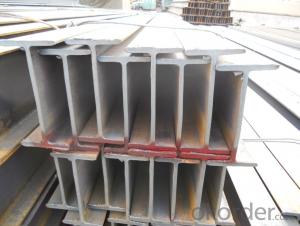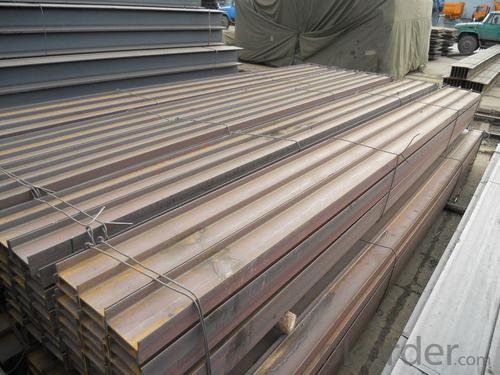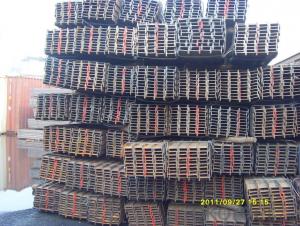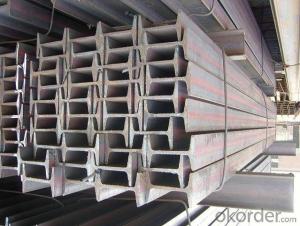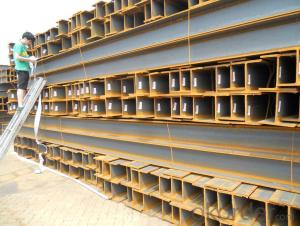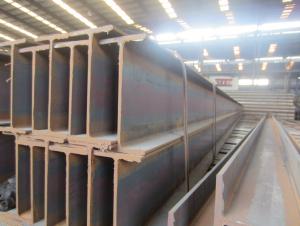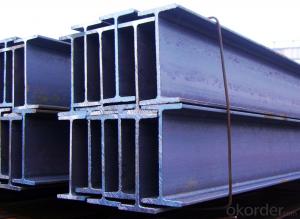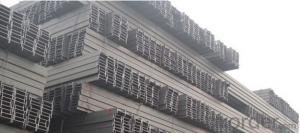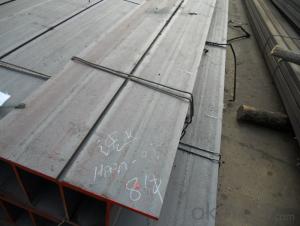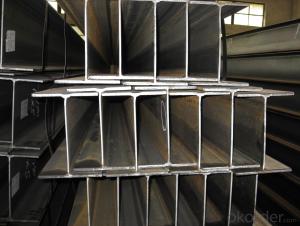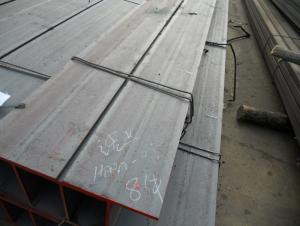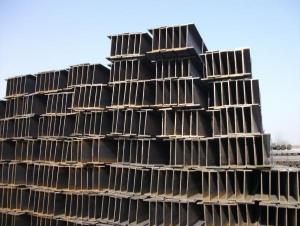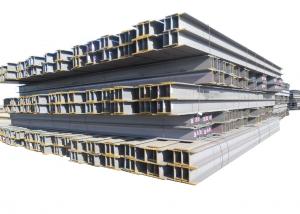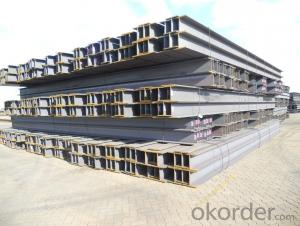H beam; structural steel;
- Loading Port:
- Tianjin
- Payment Terms:
- TT OR LC
- Min Order Qty:
- 1000 m.t.
- Supply Capability:
- 10000 m.t./month
OKorder Service Pledge
OKorder Financial Service
You Might Also Like
Product Description:
Product Description:
Specifications of Hot Rolled Structural Steel H Beam
1. Standard: GB700-88, Q235B2.
2. Grade: Q235, SS400 or Equivalent
3. Length: 6m,10m, 12m as following table
4. Invoicing on theoretical weight or actual weight as customer request
5.Payment: TT or L/C
6. Sizes:
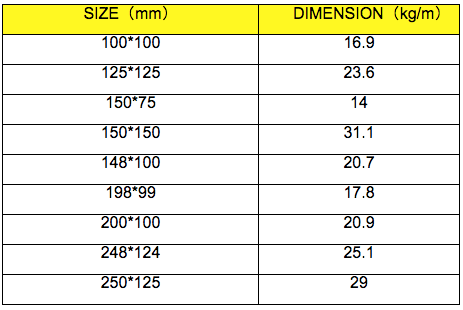
Usage & Applications of Hot Rolled Structural Steel H Beam
Commercial building structure ;Pre-engineered buildings; Machinery support structure; Prefabricated structure; Medium scale bridges; Ship-building structure. etc.
Packaging & Delivery of Hot Rolled Structural Steel H Beam
1. Packing: it is nude packed in bundles by steel wire rod
2. Bundle weight: not more than 3.5MT for bulk vessel; less than 3 MT for container load
3. Marks:
Color marking: There will be color marking on both end of the bundle for the cargo delivered by bulk vessel. That makes it easily to distinguish at the destination port.
Tag mark: there will be tag mark tied up on the bundles. The information usually including supplier logo and name, product name, made in China, shipping marks and other information request by the customer.
If loading by container the marking is not needed, but we will prepare it as customer request.
4. Transportation: the goods are delivered by truck from mill to loading port, the maximum quantity can be loaded is around 40MTs by each truck. If the order quantity cannot reach the full truck loaded, the transportation cost per ton will be little higher than full load.
5. Delivered by container or bulk vessel
Production flow of Hot Rolled Structural Steel H Beam
Material prepare (billet) —heat up—rough rolling—precision rolling—cooling—packing—storage and transportation
- Q: Can Steel H-Beams be used in museum or gallery construction?
- Yes, Steel H-Beams can be used in museum or gallery construction. Steel H-Beams are commonly used in construction due to their strength and durability. They provide structural support and can withstand heavy loads, making them suitable for large and open spaces like museums and galleries. Additionally, Steel H-Beams are versatile and can be fabricated to meet specific design requirements, allowing for unique architectural features. Their fire resistance properties also make them a safe choice for such buildings. Overall, Steel H-Beams are a popular choice in construction, including museum and gallery projects, due to their strength, versatility, and safety features.
- Q: Can steel H-beams be used in the construction of agricultural buildings?
- Yes, steel H-beams can be used in the construction of agricultural buildings. Steel H-beams are commonly used in construction due to their strength and durability. They provide structural support and can withstand heavy loads, making them suitable for agricultural buildings such as barns, storage facilities, or livestock shelters. Steel H-beams are also resistant to pests, rot, and fire, making them a practical choice for agricultural applications.
- Q: What are the different methods of protecting steel H-beams from corrosion?
- There are several methods available to protect steel H-beams from corrosion. 1. Galvanization: This method involves coating the steel beams with a layer of zinc. The zinc acts as a sacrificial anode, corroding first to protect the steel from oxidation. Galvanized steel beams are highly resistant to corrosion and can withstand harsh environments. 2. Paint Coating: Applying a protective paint coating to steel H-beams can also prevent corrosion. The paint creates a physical barrier between the steel and the surrounding environment, preventing moisture and oxygen from reaching the metal surface. Regular maintenance and periodic repainting may be required to ensure long-term protection. 3. Epoxy Coating: Epoxy coatings are commonly used in industrial settings to protect steel beams from corrosion. The epoxy forms a strong, durable barrier that resists moisture, chemicals, and UV radiation. This method provides excellent protection against corrosion and can be applied in various thicknesses to meet specific requirements. 4. Powder Coating: Powder coating involves applying a dry powder to the steel beams, which is then heated and fused to form a protective layer. This method provides a durable, chip-resistant coating that offers excellent corrosion protection. Powder coatings are available in a wide range of colors and finishes. 5. Cathodic Protection: This method involves connecting the steel H-beams to a sacrificial anode, such as zinc or magnesium, through an electrical circuit. The anode corrodes instead of the steel beams, effectively protecting them from oxidation. Cathodic protection is often used in marine environments or structures buried in soil. 6. VCI (Vapor Corrosion Inhibitor): VCI methods involve using special packaging materials containing vapor corrosion inhibitors. These inhibitors release a protective vapor that forms a molecular layer on the steel surface, preventing corrosion. VCI techniques are commonly used for protecting steel H-beams during shipping and storage. It's important to consider the specific application, environmental conditions, and budget when choosing the most suitable method of protecting steel H-beams from corrosion.
- Q: How do steel H-beams contribute to energy efficiency?
- Steel H-beams contribute to energy efficiency by providing a strong and durable structural support system that allows for the construction of energy-efficient buildings. These beams have high load-bearing capacity, which enables the use of lighter building materials, such as insulated panels, reducing the overall weight of the structure. Additionally, the versatility of H-beams allows for the design of open and flexible floor plans, facilitating the installation of energy-efficient systems like HVAC, lighting, and insulation. Moreover, steel is a recyclable material, minimizing waste and reducing the environmental impact associated with construction, further enhancing energy efficiency.
- Q: Can steel H-beams be used in residential roof structures?
- Yes, steel H-beams can be used in residential roof structures. Steel H-beams are commonly used in construction due to their strength and durability. They provide excellent load-bearing capabilities and can support heavy roof loads. Additionally, steel H-beams are resistant to fire, termites, and other pests, making them a reliable choice for residential roof structures. However, it is important to ensure proper engineering and design, as well as adherence to local building codes and regulations, when incorporating steel H-beams into roof structures.
- Q: How long do steel H-beams typically last?
- Steel H-beams typically have a very long lifespan and can last for several decades or even longer, depending on various factors such as the quality of the steel, environmental conditions, and maintenance.
- Q: What are the different connection methods used for steel H-beams?
- Steel H-beams can be connected using various methods, depending on the project's specific needs. Some commonly used methods include the following: 1. Welding: Welding is a popular choice for connecting steel H-beams. It involves melting the beam edges and fusing them together using a welding electrode. This method ensures a strong and durable connection, guaranteeing structural integrity. 2. Bolting: Another frequently used method is bolting, which involves securing the beams together using bolts and nuts. This method allows for easy disassembly and reassembly, making it flexible for different construction projects. 3. Riveting: Although less common nowadays, riveting is still occasionally used to connect steel H-beams. It requires drilling holes in the beams and using rivets to secure them. While time-consuming, this method offers a strong and reliable connection. 4. Adhesive bonding: A modern approach is adhesive bonding, which utilizes high-strength adhesives to bond steel H-beams. This method offers advantages like uniform stress distribution and corrosion resistance. However, it requires specialized knowledge and careful implementation. 5. Mechanical connectors: Mechanical connectors, such as shear connectors or moment-resisting connections, are specifically designed for joining steel H-beams. These connectors provide a reliable and efficient means of connection, often using bolts or welds for added strength. Each connection method has its own advantages and considerations, depending on factors like load-bearing requirements, ease of installation, and project timeline. It is crucial to consult with structural engineers and adhere to industry standards and codes when selecting the appropriate connection method for steel H-beams in any construction project.
- Q: Can steel H-beams be used for industrial warehouses?
- Yes, steel H-beams are commonly used for constructing industrial warehouses due to their structural strength, durability, and ability to support heavy loads.
- Q: What are the welding requirements for steel H-beams?
- The welding requirements for steel H-beams are determined by several factors including the specific steel grade, the thickness of the beams, the type of welding process being used, and the intended application of the beams. Firstly, it is important to select the appropriate steel grade for the H-beams. Commonly used steel grades for H-beams include ASTM A36, ASTM A572, and ASTM A992. These grades have different mechanical properties and welding characteristics, so it is crucial to consult the manufacturer's specifications or relevant welding codes to determine the suitable steel grade for the specific application. Next, the thickness of the H-beams is an important factor that affects the welding requirements. Thicker beams may require preheating before welding to control the cooling rate and minimize the risk of hydrogen-induced cracking. Preheating temperatures and durations should be determined based on the steel grade and thickness, and the specific welding code being followed. The type of welding process being used is another crucial consideration. Common welding processes for H-beams include shielded metal arc welding (SMAW), gas metal arc welding (GMAW), and flux-cored arc welding (FCAW). Each process has its own set of requirements in terms of electrode selection, welding parameters, and post-weld heat treatment. Proper fit-up and joint preparation are also important for achieving high-quality welds on H-beams. The beams should be properly aligned and positioned to ensure full penetration of the weld and minimize distortion. Joint preparation, such as beveling or grinding, may be necessary to achieve appropriate groove dimensions for certain welding processes. Additionally, it is important to consider any specific requirements for post-weld heat treatment or inspection. Some applications may require stress relieving or annealing of the welded H-beams to improve their mechanical properties or reduce residual stresses. Nondestructive testing methods, such as ultrasonic or magnetic particle inspection, may be necessary to ensure the integrity of the welds. Overall, the welding requirements for steel H-beams are dictated by the steel grade, beam thickness, welding process, and application. It is essential to consult relevant welding codes, manufacturer specifications, and engineering professionals to determine the specific welding procedures, parameters, and quality control measures necessary to achieve reliable and structurally sound welds on H-beams.
- Q: How are steel H-beams connected to other structural elements?
- Steel H-beams, also known as I-beams, are commonly used in construction to provide structural support for various applications. These beams are connected to other structural elements in different ways depending on the specific design and requirements of the project. One common method of connecting steel H-beams to other structural elements is through welding. Welding is a process that involves melting the edges of the beams and fusing them together using a high-intensity heat source. This creates a strong and durable connection between the H-beam and the other elements. Welding is particularly useful when the connection needs to withstand high loads or forces. Another method of connecting steel H-beams is through bolting. Bolts are inserted through pre-drilled holes in the flanges or webs of the beam, and nuts are tightened to secure the connection. This method allows for easy disassembly and reassembly if required. Bolting is commonly used when the connection needs to be adjustable or when welding is not feasible due to specific project constraints. In addition to welding and bolting, steel H-beams can also be connected to other structural elements using various mechanical connectors. These connectors, such as brackets, plates, or cleats, are designed to provide a secure and rigid connection between the beam and the other elements. Mechanical connectors are often used in combination with welding or bolting to enhance the overall strength and stability of the connection. It is important to note that the specific method of connecting H-beams to other structural elements may vary depending on factors such as the load requirements, design considerations, and building codes. Professional engineers and construction experts carefully evaluate these factors to determine the most appropriate and efficient method of connection for each specific project.
Send your message to us
H beam; structural steel;
- Loading Port:
- Tianjin
- Payment Terms:
- TT OR LC
- Min Order Qty:
- 1000 m.t.
- Supply Capability:
- 10000 m.t./month
OKorder Service Pledge
OKorder Financial Service
Similar products
Hot products
Hot Searches
Related keywords


